In order to increase the realism of his fictional world J.R.R. Tolkien had to come up with a huge number of dates for the births and deaths of his characters. This might seem like a straightforward process but is actually highly influenced by a variety of variables. Humans have been shown to be very bad at generating random sequences of numbers in several scientific studies. There is often a preconceived idea of what a random sequence of digits should look like. Consideration is taken to previous numbers in order to make the sequence look more random even though each number should be generated independently. Because of this, the probability of the same number appearing multiple times in a row is often underestimated.
Number generation can also be influenced by psychological factors such as emotional response. A study by Marisca Milikowski of the University of Amsterdam showed that even numbers are generally seen as good and calm, and odd numbers as bad and exciting. Similarly, a study by Dan King of the National University of Singapore and Chris Janiszewski of the University of Florida showed that even numbers were generally better liked than odd numbers. If you are interested in knowing more about this you can find a nice write-up on emotional reactions to numbers by Alex Bellos here.
I was curious to see if there were any hidden patterns which could be seen among the numbers Tolkien chose for his fictional world. I decided to primarily look at the frequency of the last two digits of the years of birth for characters. These should, in theory, be relatively evenly distributed and, unlike death dates, not influenced by major events such as battles.
Since each final digit should be equally probable there should also be a relatively equal distribution between even and odd numbers. This was set as the null hypothesis and tested using binomial tests for the various analyzed data sets. The results are given as the probability p that the observed data could have occurred by chance. The significance level was chosen as p < 0.01.
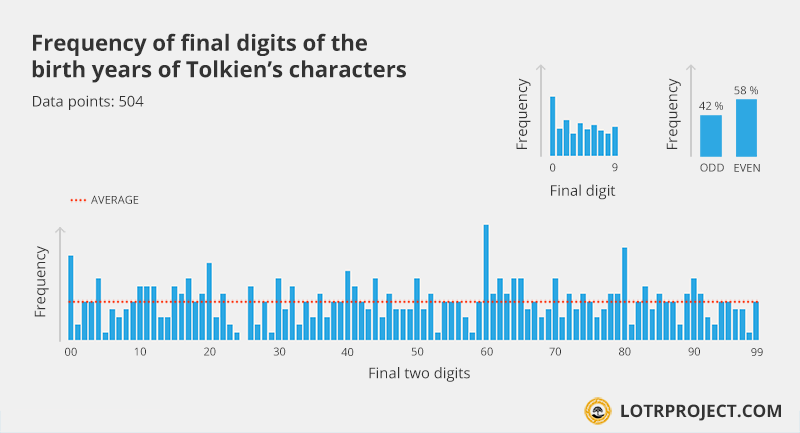
Looking at known birth years of all characters (see above) it certainly looks as if Tolkien generally preferred even numbers and particularly liked numbers ending in -0. Years ending in -60 and -80 stand out as highly popular. A binomial test on the distribution between even and odd numbers gave p = 0.0003 which is significant at p < 0.01.
I found the results incredibly intriguing and showed them to my good friends Shaun Gunner and Troels Forchhammer, both of whom have been trusted advisers on many of my Tolkien related projects. They both suggested looking more closely at how numbers ending in -0 affected the results. Looking at the distribution between years ending in 0 and 1 – 9 using a binomial test gave p = 1.011e-09. It is therefore likely that the high frequency of years ending in -0 influences the result heavily. If years ending in -0 are excluded there is no significant difference between even and odd numbers (p = 0.14). This means that we can quite confidently reject the null hypothesis of equal probability and say that Tolkien had a preference for numbers ending in -0 but we cannot say if he had a preference for even numbers in general.
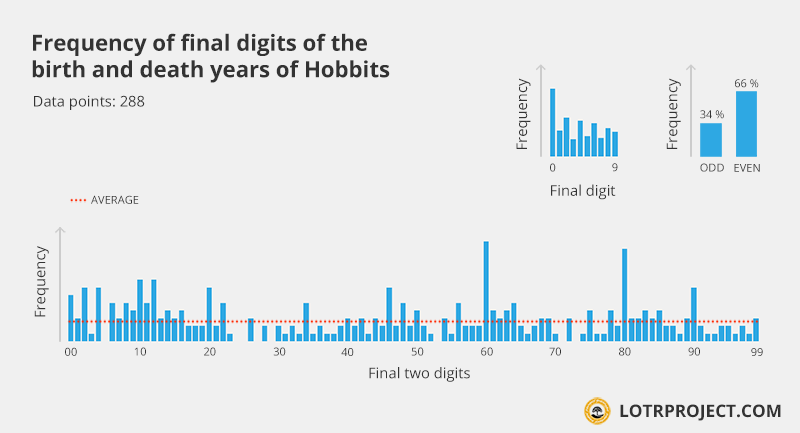
Shaun was curious about how the result would differ between different races and suggested analyzing the Hobbits and the other characters separately. Since the Hobbits lived incredibly uneventful lives, mostly unaffected by the events of the outside world, I decided to also include their death dates. This was in order to increase the amount of data points. No significant difference in distribution was found between birth years and death years of Hobbits.
I found that the difference in frequency between odd and even numbered years is bigger when looking only at Hobbits (see above) and smaller when looking at the rest of the characters (see below). Binomial tests on the distributions between odd and even numbers gave p = 1.25e-07 for the Hobbits and p = 0.2458 for the other characters. When years ending in -0 were excluded a binomial test gave p = 0.0007422 for the Hobbits and p = 0.6979 for the other characters.
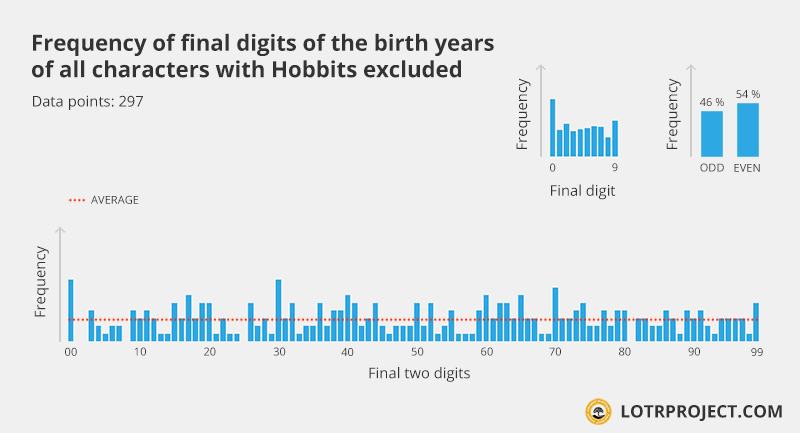
This quite clearly shows that Tolkien favored even numbers for Hobbits but not for the other characters. We know that Tolkien was particularly fond of Hobbits. Is it possible that he subconsciously associated them with even numbers because of his love for them? It is definitely possible.
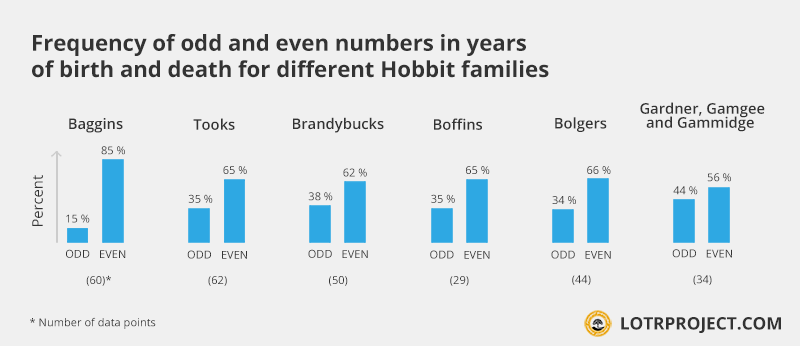
After having discovered this rather peculiar pattern, Shaun and I were interested in looking into differences between different Hobbit families (see above). Most Hobbit families show roughly the same frequency of even and odd numbers with one notable exception. The Baggins family has a remarkable 85 % share of even numbers among their birth and death dates. Even with a sample size of only 60 dates a binomial test resulted in p = 3.09e-08. Comparing the Baggins with the rest of the Hobbits using a Chi Squared test gave p = 0.00063 which is significant at p < 0.01. This means that frequency of odd/even birth and death year is dependent on whether or not a character is a member of the Baggins family. Could it be the case that Tolkien subconsiously showed that he loved Hobbits more than other characters and members of the Baggins family the most?
A distinction between good and bad numbers does not have to be the only explanation for the difference in frequency between even and odd numbers. A study by psychologists Galen Bodenhausen and James Wilkie at Northwestern University revealed that people tend to assign genders to numbers. They found that even numbers are considered more feminine and odd numbers more masculine. At first glance, these results does not appear to be reflected in the data from Tolkien’s works. As I have shown before, roughly 80 % of the characters in Tolkien’s works are male and as we have seen Tolkien showed a preference for even numbers.
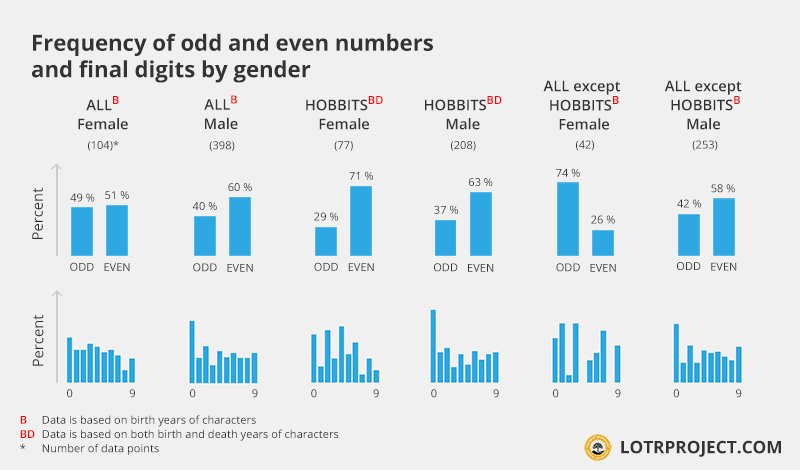
Still, female Hobbits show an increase in even numbered years of birth and death which Troels pointed out might indicate a gender based effect. Unfortunately the difference in frequency and the sample size is not large enough to show a statistically significant difference.
However, as mentioned before Tolkien appears to have had a general preference for years ending in -0 and this is very prominent for the data of male Hobbits. What if we remove the results ending in -0 and compare female and male data using a Chi-square on the final digits 1 – 9 only. Now we get p = 2.64e-07 which is significant at p < 0.01. It appears that there might be a gender based effect on Hobbit characters after all.
As you have probably noticed there is a huge difference between female and male characters when Hobbits are excluded in the graph above. This appears to contradict the previous analysis since odd numbers are more frequent than even numbers for female characters. A Chi-square test gives p = 0.054 which is not significant at p < 0.01. However, when excluding numbers ending in -0 a Chi-square test gives p = 0.00012 which is significant at p < 0.01. There appears to be a reverse gender effect for non-Hobbit characters.
So what does this mean?
We can confidently say that Tolkien had a general preference for years ending in -0. Furthermore, it was found that Tolkien for some reason preferred even numbers for Hobbits. This was also found to be the case even after accounting for his general preference for numbers ending in -0. The effect was remarkably high for the Baggins family. No significant difference in frequency between even and odd numbered years was found for the other characters. Knowing of Tolkien’s fondness of Hobbits this result appears to indicate that he might have subconsciously assigned even years more frequently because of his love for them.
Female Hobbits showed a higher frequency of even numbers than did male Hobbits. This appears to confirm the theory that even numbers are viewed as more feminine than odd. However, this effect was reversed when looking at the other characters.
Ultimately we can say that there are statistically significant differences which means that Tolkien must have been subconsciously influenced by something. It will most likely never be possible to say for certain what that something was but it shows how complex our relationship with numbers is. One way to shed further light on this would be to look at the important events throughout the history of Arda. It would be interesting to see if there is a correlation between the percieved “goodness” of an event and the likelihood of the year being even numbered.
I think Troels put it very nicely when he said “statistics doesn’t give us the answers: it helps us ask better questions”. It is my hope that this study will raise some interesting questions on the psychology of numbers and what influenced Tolkien when constructing his fictional world.
—
I would like to thank Shaun Gunner, chairman of the Tolkien Society, for his advise and thoughts regarding the results. I would also like to thank Troels Forchhammer for his input and advise on the statistical analysis.
]]> ]]>
]]>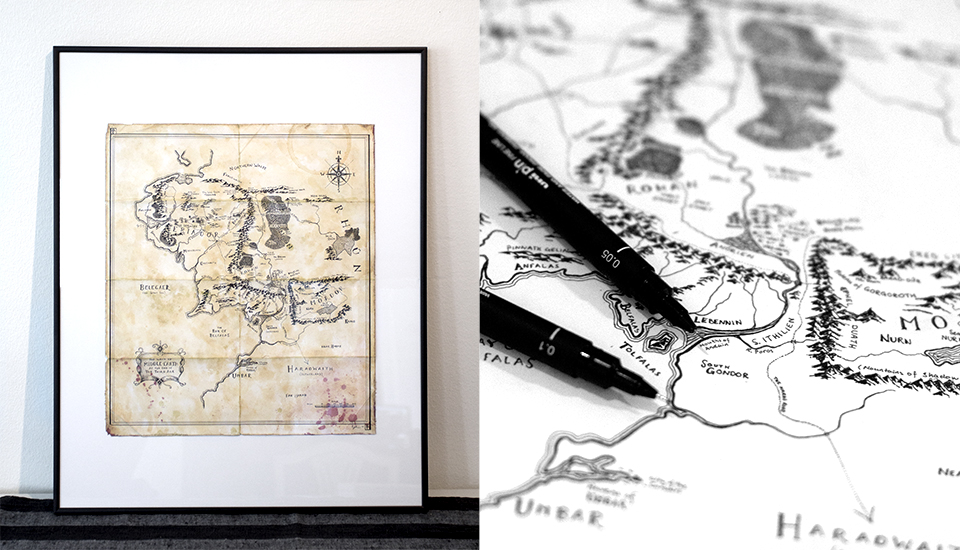
I have wanted a map of Middle-earth to hang on the wall for a while now. It’s probably something most Tolkien fans desire at one point or another. There are a few really great ones available for purchase but since I love creating things I wanted to make one myself. The problem with a project like that is that it requires quite a lot of time and once I start something I usually want to finish it without interruptions. Luckily, these last few days I finally found both the time and inspiration to start the project. You will find images and some comments about the process below.
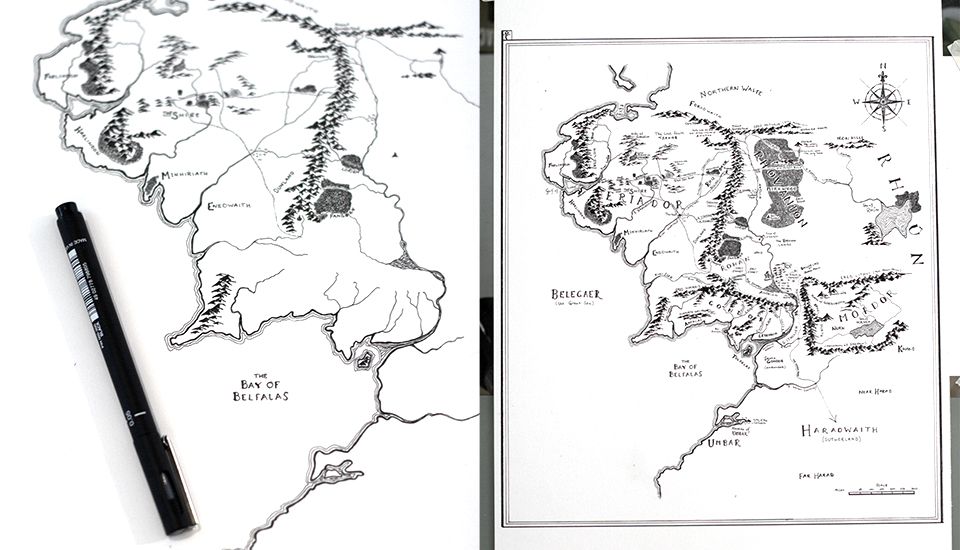
I decided to base the map on the one Tolkien drew for the Lord of the Rings with some small modifications to the design and additions of features which were not on the original map. I drew the map using a Uni Pin fineliner pen (0.05 mm tip) which allowed me to get a lot of small details on there. This was a fairly time consuming process which probably took about 10 hours in total.
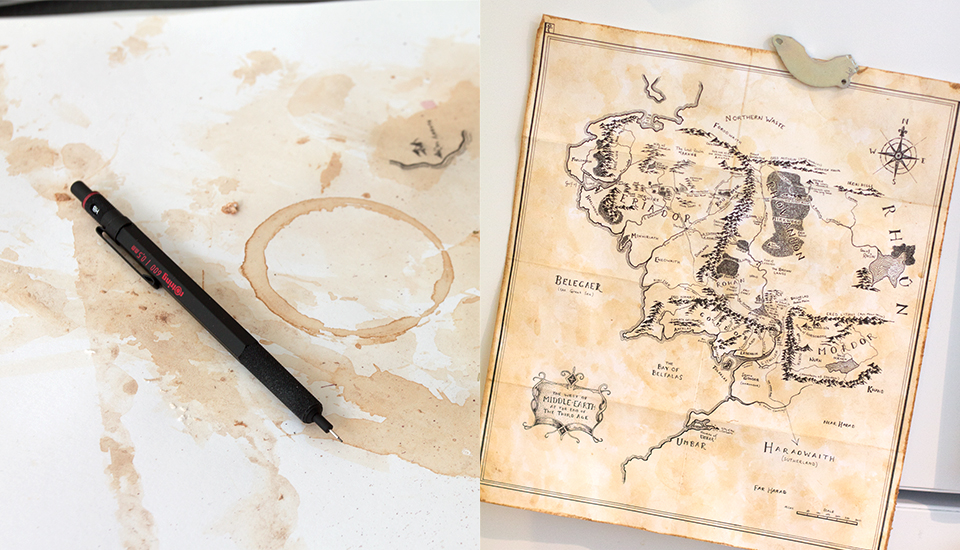
Since I wanted the map to look old and worn out, I used some Earl Grey tea to weather it. I wet the edges and scraped them with a knife to get a rough look. This also helped open up the fibers which allowed the paper to absorb the tea better and create some nice darkened edges. In order to get some variety in the weathering I added some splatter of red and green and a bit of coffee. As a last touch I folded it a few times to make it look used. The entire process took about two days and I am quite happy with how it turned out.
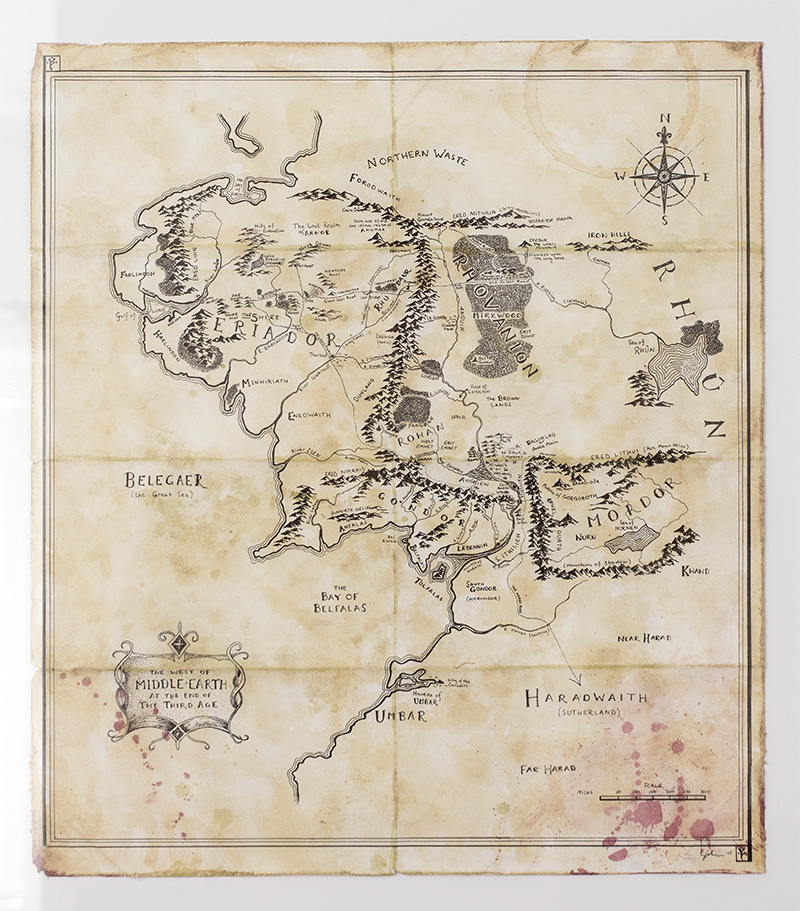
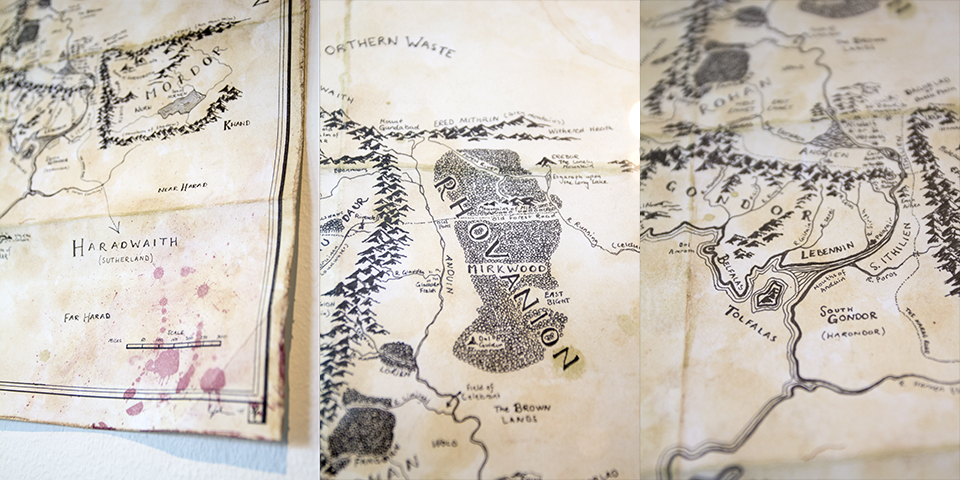
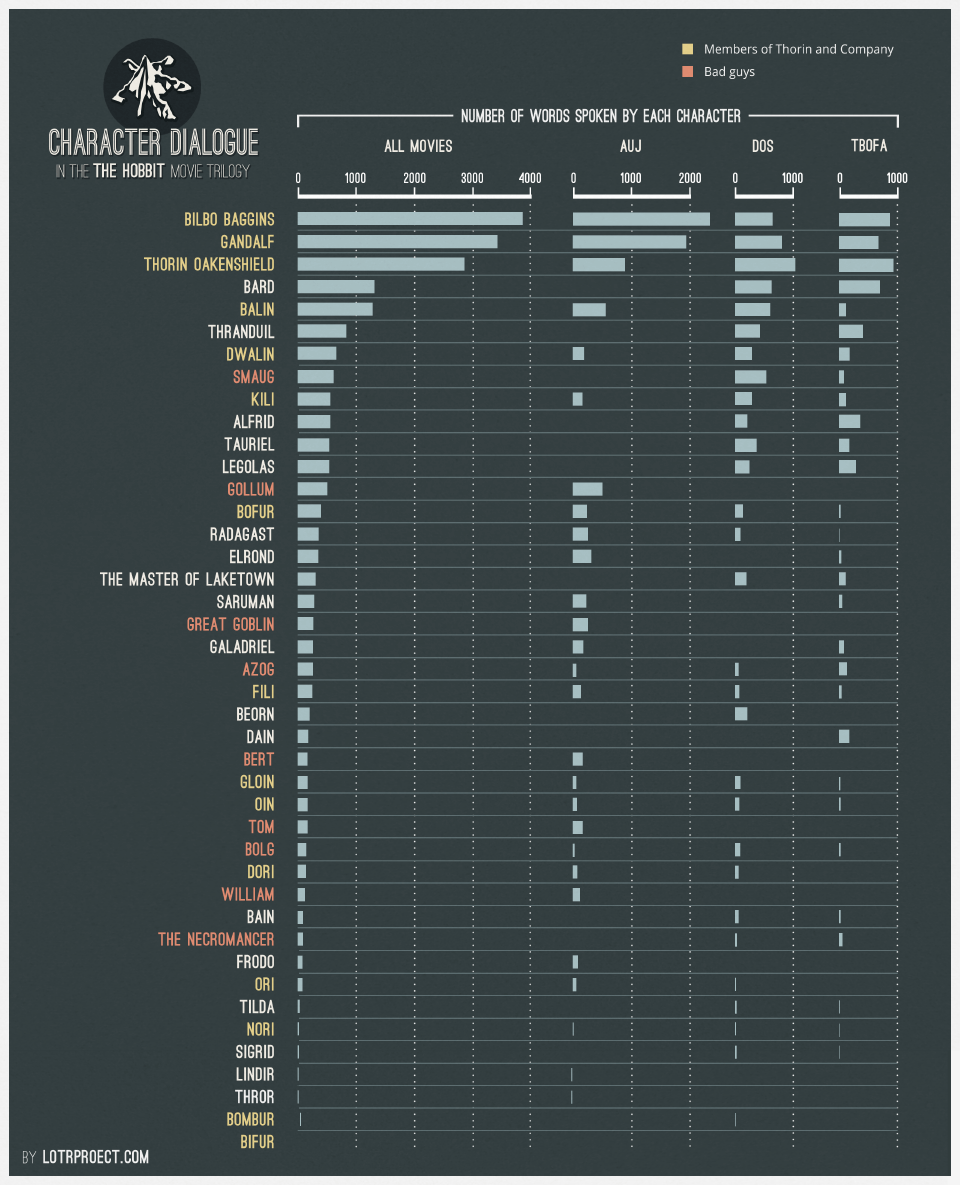
The total dialogue is 9162, 7270 and 5784 words for An Unexpected Journey, The Desolation of Smaug and The Battle of Five Armies respectively. The first movie has quite a lot more dialogue which can be attributed to the lengthy introduction to the quest in the beginning.
The data for this analysis has been put together by the Google+ page The Hobbit Movies of which I am one of the admins. It should not be considered absolutely accurate but rather a good estimate of the dialog.
]]>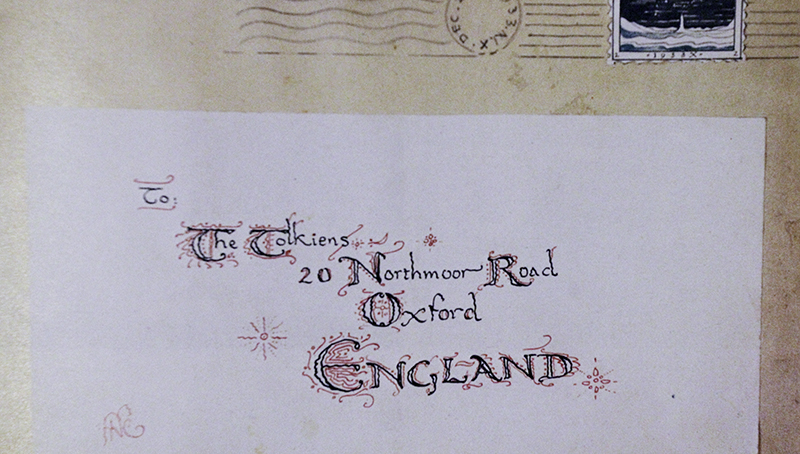
The letters told the stories of the adventures of Father Christmas along with his various helpers, most notably the North Polar Bear who seemed to constantly get himself into trouble. A selection of these letters were posthumously published in 1976 as a wonderful book called Letters from Father Christmas. This book has been in my bookshelf since I was a child and is one I return to every Christmas.
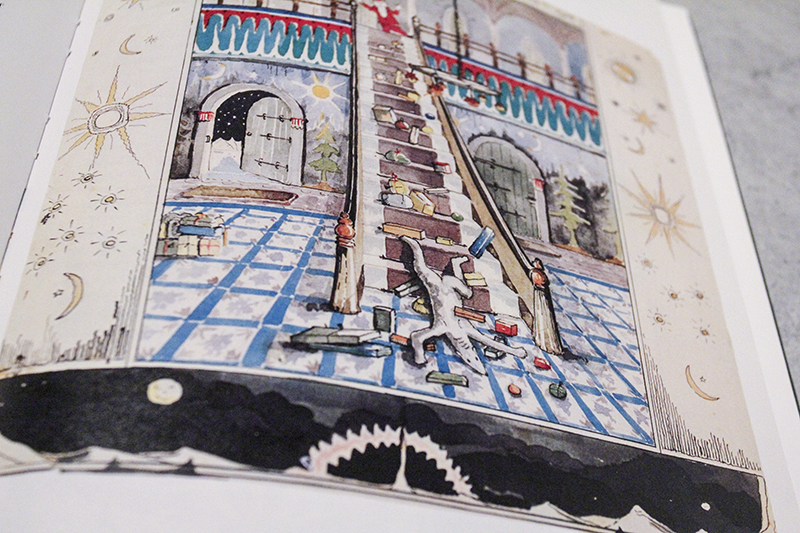
Below is one of the letters from the book.
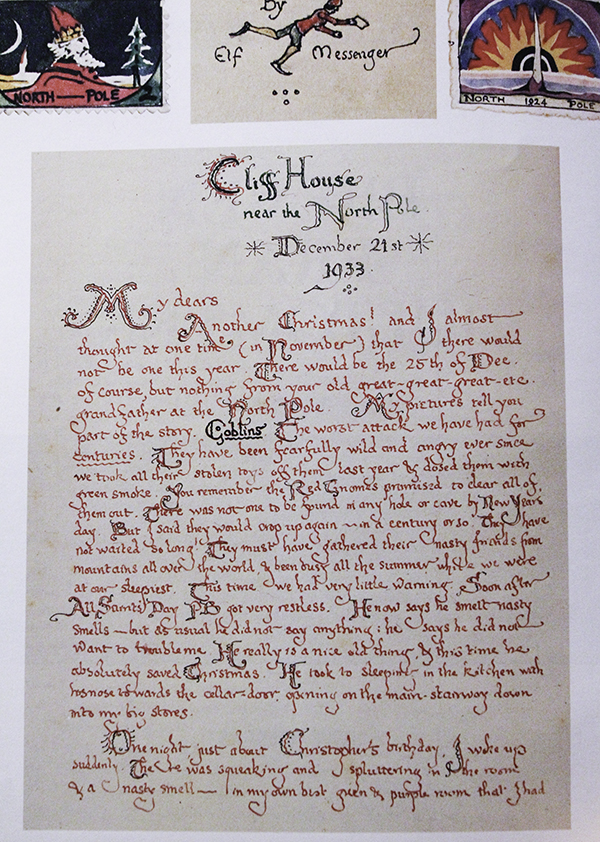
—
Cliff House
Near the North Pole
December 21st, 1933
Another Christmas! And I almost thought at one time (in November) that there would not be one this year. There would be the 25th of December of course, but nothing from your old great-great-great-etc. grandfather at the North Pole. My pictures tell you part of the story. Goblins. The worst attack we have had for centuries. They have been fearfully wild and angry ever since we took all their stolen toys off them last year, and dosed them with green smoke. You remember the Red Gnomes promised to clear all of them out. There was not one to be found in any hole or cave by New Year’s Day. But I said they would crop up again – in a century or so. They have not waited so long! They must have gathered their nasty friends from mountains all over the world, and been busy all the summer while we were at our sleepiest. This time we had very little warning. Soon after All Saints’ Day, Polar Bear got very restless. He now says he smelt nasty smells – but as usual he did not say anything: he says he did not want to trouble me. He really is a nice old thing, and this time he absolutely saved Christmas. He took to sleeping in the kitchen with his nose towards the cellar-door, opening on the main stairway down into my big stores.
—
]]>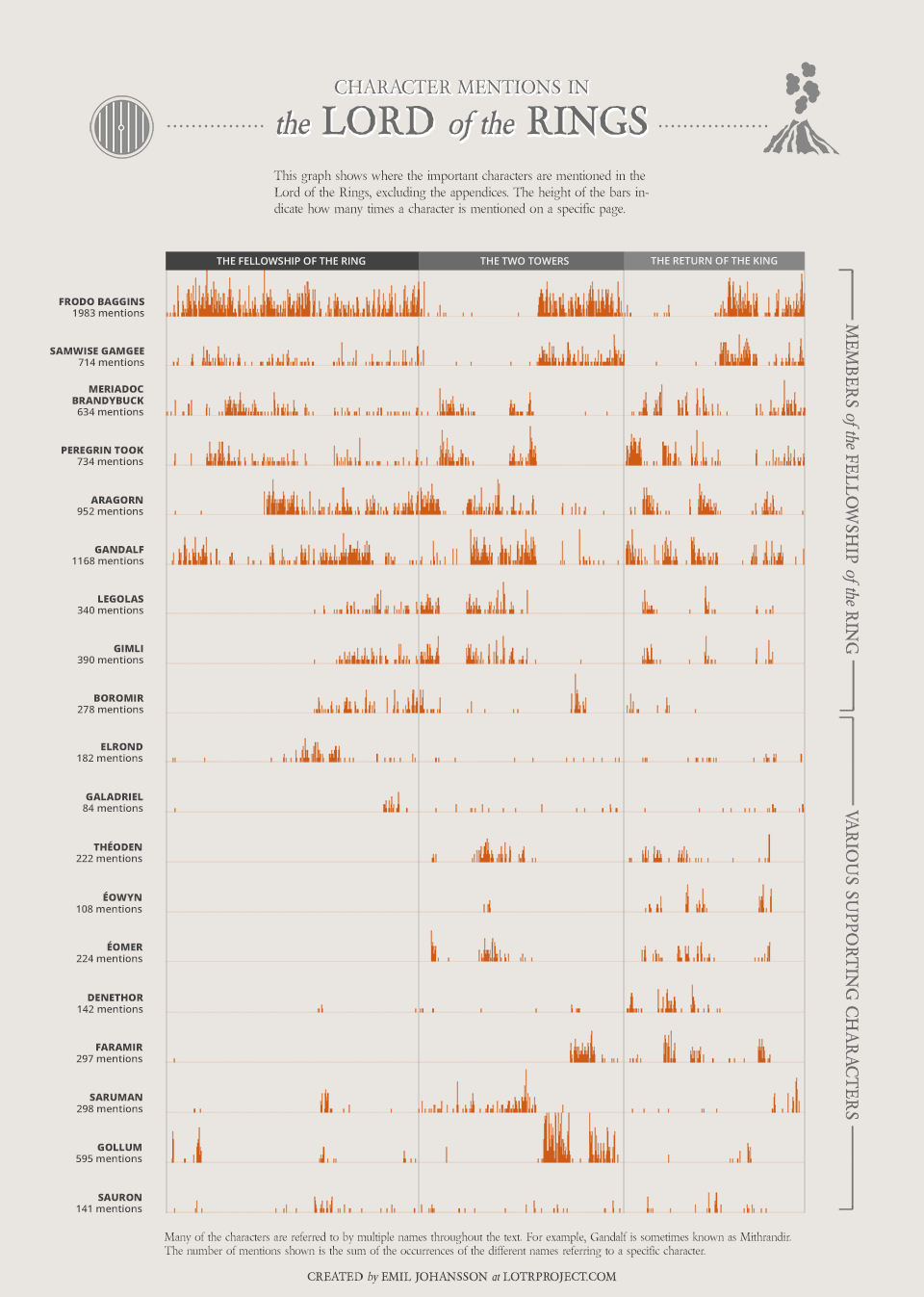

When the Hobbit: An Unexpected Journey was released I created a Dwarf cheat sheet to make it a bit easier to distinguish between the numerous Dwarves featured in the movie. Here is an updated version with two additional Dwarves: Thráin and Dain Ironfoot. I have also made it a bit more aesthetically pleasing.
]]> ]]>
]]>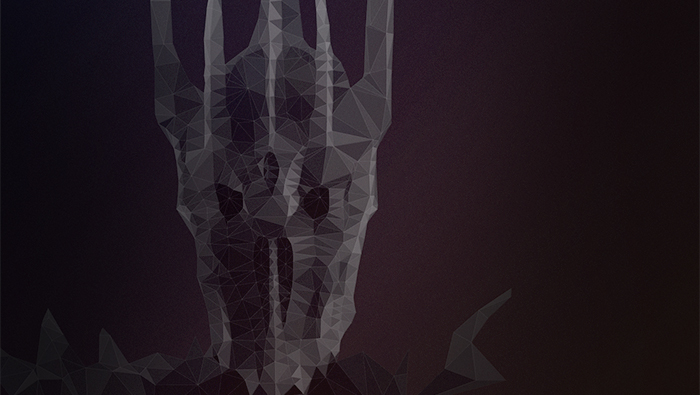
“Old fool!” he said. “Old fool! This is my hour. Do you not know Death when you see it? Die now and curse in vain!” And with that he lifted high his sword and flames ran down the blade.”

A chart showing the characteristics of Hobbits. It is, of course, very general and there are differences between different Hobbit families. The Took Family were more adventurous than other Hobbits for example.
]]>